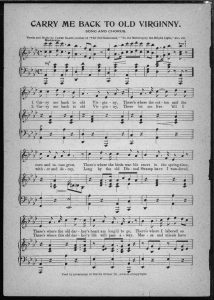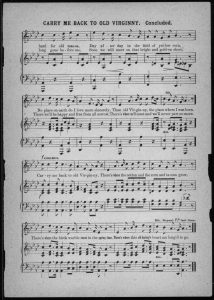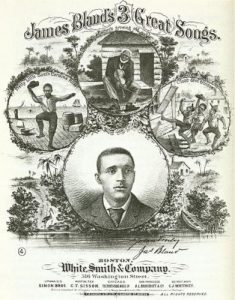The act of blackface minstrelsy was a form of entertainment in white American circles that started in the 1830’s and fell from popularity in the 1920’s.4 It serves to imitate the culture of African Americans, and consists of white performers who painted their faces black to resemble African Americans. The act itself was incredibly racist, serving to exaggerate and exemplify harmful stereotypes of African Americans. Some examples of this are exaggerated characters, deliberately painting a smile on their faces to perpetuate the lie that black people are happy to be enslaved, and highly exaggerating elements of African American culture, such as their dancing, singing, and vernacular. The use of music also helped with this, as music is a powerful way to shape opinion, and minstrel shows were not found without music accompanying. By the 1850’s, the peak of minstrelsy, the typical minstrel show had two parts: the first part with comic exchanges, ballads, and solo performances, and the second part which was vaudeville with specialty acts, clog dances, jigs, female impersonations, and burlesque of popular dramas.4 And the craziest part: these performances were normalized within the white community, being one of the most popular forms of entertainment of it’s time. There were ten theaters in New York alone dedicated to minstrelsy.4
Minstrel troupes were most popular in the North, but were found throughout the United States. Some more well known troupes would tour often, as shown in the primary source above. The source is from the November 18, 1856 copy of the New Orleans Daily Creole, and advertises the third week of the celebrated Campbell Minstrels, their director Matt Peel, and their programs of “burlesque, negro farce, and black vigils” as well as a show entitled “plantation past times.”1 The advertisement also proclaims that the shows are “Negro Minstrelsy, by the Model Troupe of the World!!”1

The cover of the score for “Poor Nelly Ann,” composed by the Campbell Minstrels, depicting the troupe in (bottom photos) and out (top photos) of blackface.
This advertisement is a great example of the negative, exaggerated, and racist nature of these performances. For one, the whole troupe and the director are in fact white blackface performers, who have taken African American culture and created a negative stereotypical experience.
In a program from the Campbell Minstrels from a performance in Massachusetts in 1852, there are examples of dances (quickstep) and music (banjo duet, drum and tambourine solos, bone castanet) that exemplify the African American culture.2 There are three sections, and the third section is titled with a derogatory term towards African Americans preceded by the word “plantation,” signifying that they are emulating slaves.2
However, something interesting about both the advertisement and the program is that they both advertise burlesque, which led to vaudeville, and ultimately musical theater. These elements of stage performance are still present today, and many people are unaware of the influence that minstrelsy has had over culture today. The horrific, racist act of minstrelsy may be dead today, but we still must be aware of how it is baked into the pie of American culture. We must be aware and consider these results so that we can go forward with more awareness, sensitivity, and a more inclusive headspace so that such acts of degradation will not happen again.
SOURCES
1. “Campbell Minstrels.” In New Orleans Daily Creole. New Orleans, Louisiana, November, 19, 1856. https://infoweb.newsbank.com
2. “West & Peel’s old and original Campbell Minstrels!” in American Broadsides and Ephemera. Worcester, Massachusetts. 1852. https://infoweb.newsbank.com
3. “Poor Nelly Ann’ / composed and sung by the Campbell Minstrels.” 1848. https://digitalcollections-baylor.quartexcollections.com/Documents/Detail/poor-nelly-ann-composed-and-sung-by-the-campbell-minstrels./2023272
4. Salamone, Frank A. “Minstrelsy” from Encyclopedia of American Studies. 2021. https://search.credoreference.com/articles/Qm9va0FydGljbGU6NjcwNjc=





